Principles of Administration Report: Office Procedures and Practices
VerifiedAdded on 2020/07/22
|15
|3653
|36
Report
AI Summary
This report provides a comprehensive analysis of the principles of administration, focusing on various aspects of office management and organizational practices. It delves into the legal requirements related to office facilities, including employment laws and data protection. The report explores typical office services, from filing and client record management to bookkeeping and travel arrangements. It also outlines procedures for establishing efficient office management, resource allocation, and workflow optimization. Furthermore, the report addresses health and safety obligations, accident and emergency procedures, and the importance of accurate meeting minutes. It examines different types of meetings, the roles of participants, and techniques for effective facilitation. The report also covers the use of targets and budgets, work allocation, quality management, and event planning, including information requirements and resource identification. The analysis is grounded in real-world examples, making it a valuable resource for understanding and applying administrative principles within organizations.
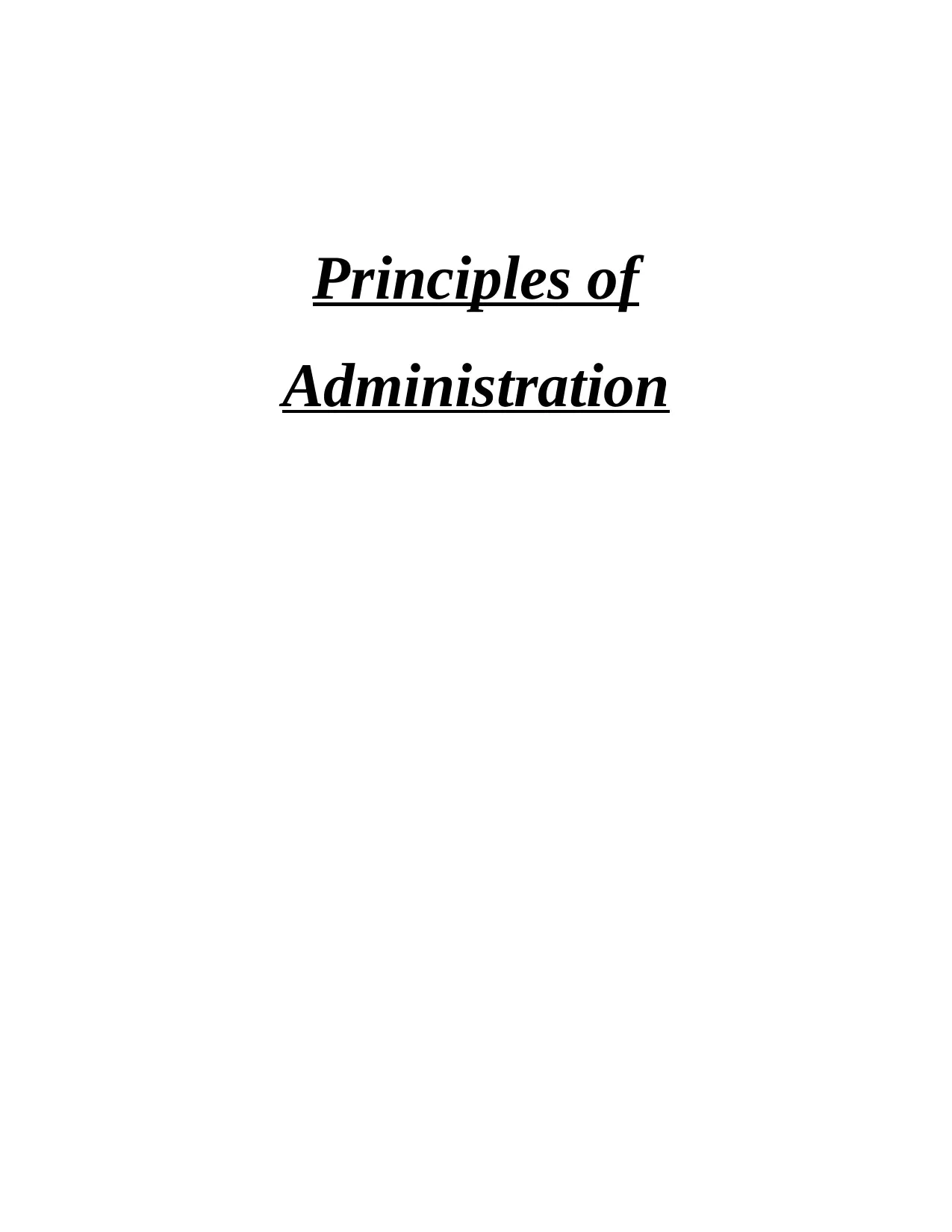
Principles of
Administration
Administration
Paraphrase This Document
Need a fresh take? Get an instant paraphrase of this document with our AI Paraphraser
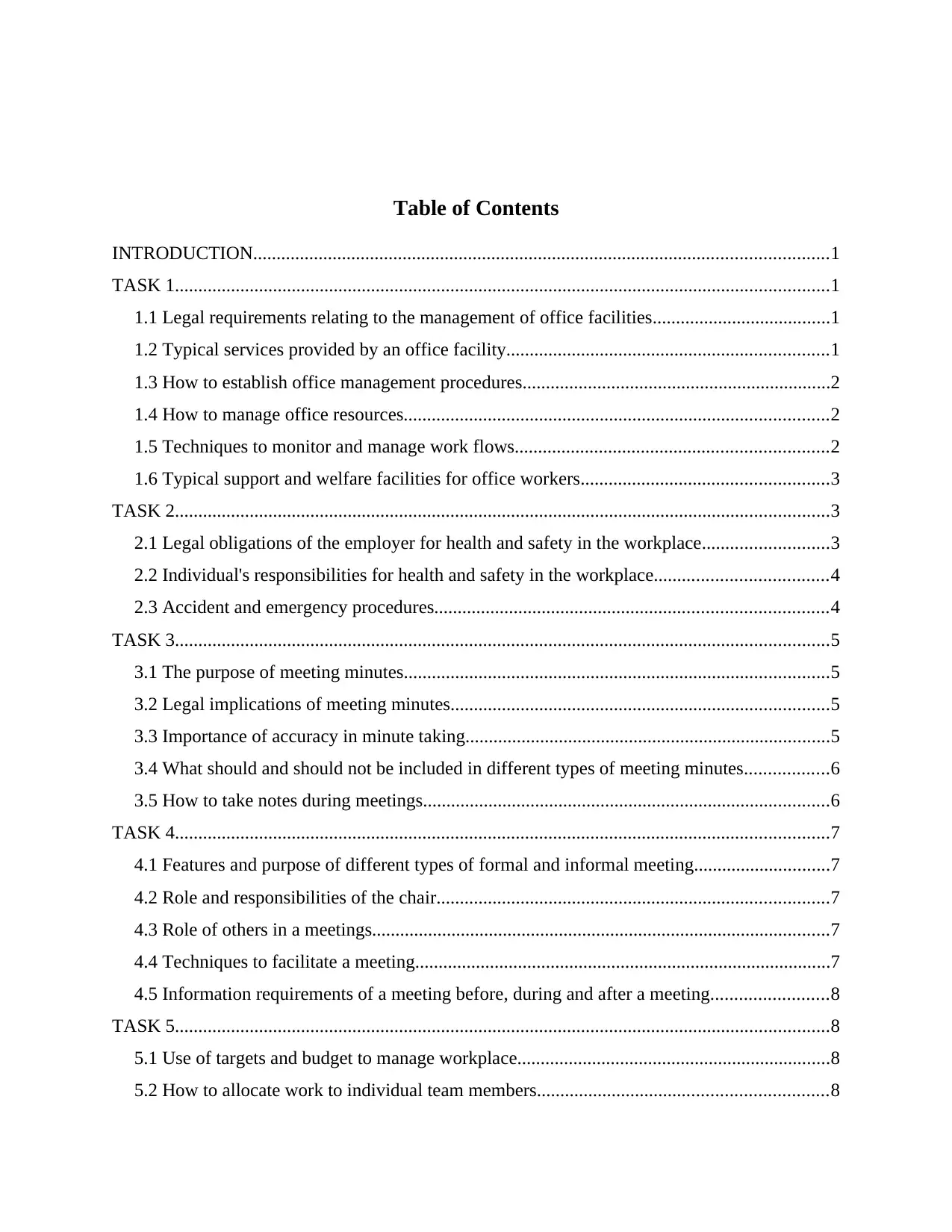
Table of Contents
INTRODUCTION...........................................................................................................................1
TASK 1............................................................................................................................................1
1.1 Legal requirements relating to the management of office facilities......................................1
1.2 Typical services provided by an office facility.....................................................................1
1.3 How to establish office management procedures..................................................................2
1.4 How to manage office resources...........................................................................................2
1.5 Techniques to monitor and manage work flows...................................................................2
1.6 Typical support and welfare facilities for office workers.....................................................3
TASK 2............................................................................................................................................3
2.1 Legal obligations of the employer for health and safety in the workplace...........................3
2.2 Individual's responsibilities for health and safety in the workplace.....................................4
2.3 Accident and emergency procedures....................................................................................4
TASK 3............................................................................................................................................5
3.1 The purpose of meeting minutes...........................................................................................5
3.2 Legal implications of meeting minutes.................................................................................5
3.3 Importance of accuracy in minute taking..............................................................................5
3.4 What should and should not be included in different types of meeting minutes..................6
3.5 How to take notes during meetings.......................................................................................6
TASK 4............................................................................................................................................7
4.1 Features and purpose of different types of formal and informal meeting.............................7
4.2 Role and responsibilities of the chair....................................................................................7
4.3 Role of others in a meetings..................................................................................................7
4.4 Techniques to facilitate a meeting.........................................................................................7
4.5 Information requirements of a meeting before, during and after a meeting.........................8
TASK 5............................................................................................................................................8
5.1 Use of targets and budget to manage workplace...................................................................8
5.2 How to allocate work to individual team members..............................................................8
INTRODUCTION...........................................................................................................................1
TASK 1............................................................................................................................................1
1.1 Legal requirements relating to the management of office facilities......................................1
1.2 Typical services provided by an office facility.....................................................................1
1.3 How to establish office management procedures..................................................................2
1.4 How to manage office resources...........................................................................................2
1.5 Techniques to monitor and manage work flows...................................................................2
1.6 Typical support and welfare facilities for office workers.....................................................3
TASK 2............................................................................................................................................3
2.1 Legal obligations of the employer for health and safety in the workplace...........................3
2.2 Individual's responsibilities for health and safety in the workplace.....................................4
2.3 Accident and emergency procedures....................................................................................4
TASK 3............................................................................................................................................5
3.1 The purpose of meeting minutes...........................................................................................5
3.2 Legal implications of meeting minutes.................................................................................5
3.3 Importance of accuracy in minute taking..............................................................................5
3.4 What should and should not be included in different types of meeting minutes..................6
3.5 How to take notes during meetings.......................................................................................6
TASK 4............................................................................................................................................7
4.1 Features and purpose of different types of formal and informal meeting.............................7
4.2 Role and responsibilities of the chair....................................................................................7
4.3 Role of others in a meetings..................................................................................................7
4.4 Techniques to facilitate a meeting.........................................................................................7
4.5 Information requirements of a meeting before, during and after a meeting.........................8
TASK 5............................................................................................................................................8
5.1 Use of targets and budget to manage workplace...................................................................8
5.2 How to allocate work to individual team members..............................................................8
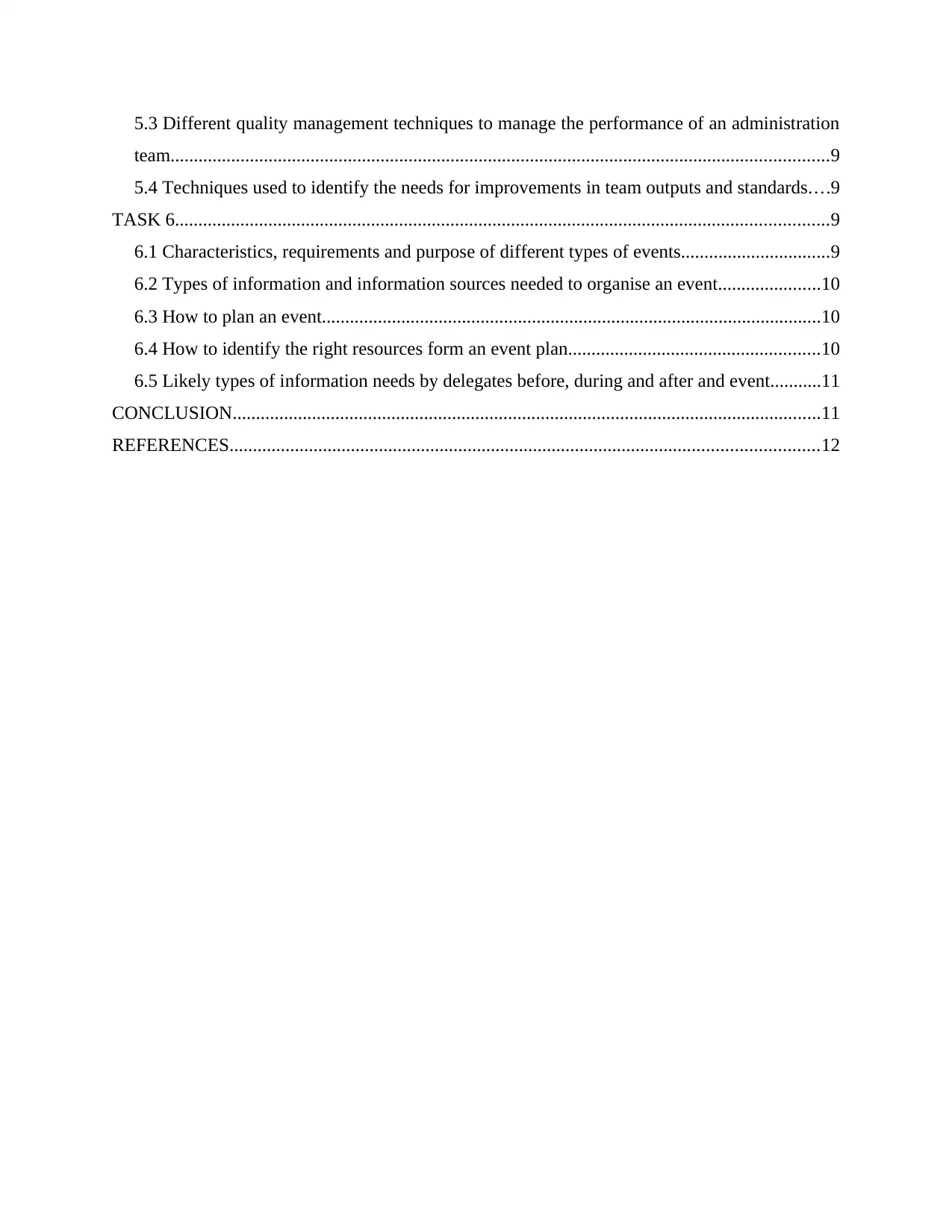
5.3 Different quality management techniques to manage the performance of an administration
team.............................................................................................................................................9
5.4 Techniques used to identify the needs for improvements in team outputs and standards....9
TASK 6............................................................................................................................................9
6.1 Characteristics, requirements and purpose of different types of events................................9
6.2 Types of information and information sources needed to organise an event......................10
6.3 How to plan an event...........................................................................................................10
6.4 How to identify the right resources form an event plan......................................................10
6.5 Likely types of information needs by delegates before, during and after and event...........11
CONCLUSION..............................................................................................................................11
REFERENCES..............................................................................................................................12
team.............................................................................................................................................9
5.4 Techniques used to identify the needs for improvements in team outputs and standards....9
TASK 6............................................................................................................................................9
6.1 Characteristics, requirements and purpose of different types of events................................9
6.2 Types of information and information sources needed to organise an event......................10
6.3 How to plan an event...........................................................................................................10
6.4 How to identify the right resources form an event plan......................................................10
6.5 Likely types of information needs by delegates before, during and after and event...........11
CONCLUSION..............................................................................................................................11
REFERENCES..............................................................................................................................12
⊘ This is a preview!⊘
Do you want full access?
Subscribe today to unlock all pages.

Trusted by 1+ million students worldwide
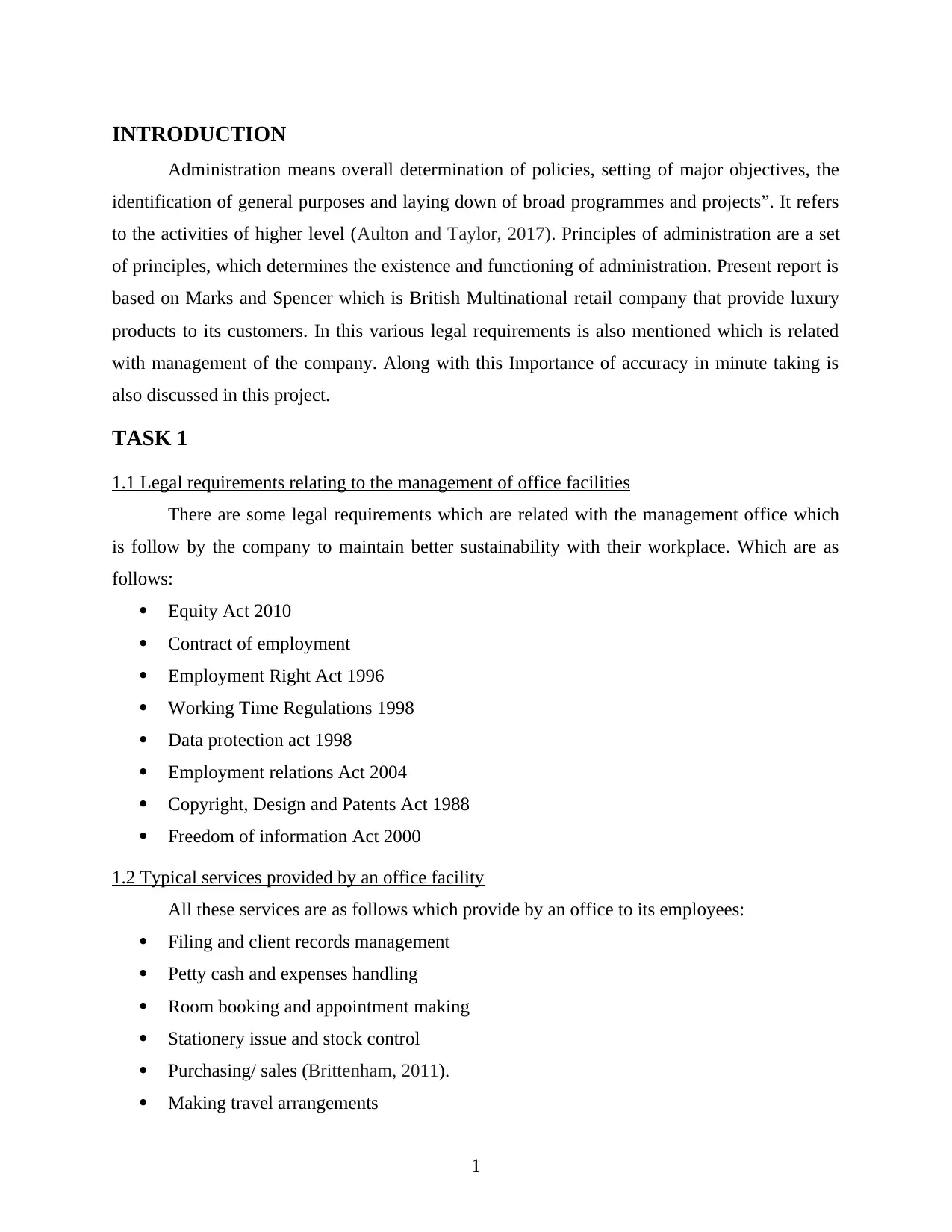
INTRODUCTION
Administration means overall determination of policies, setting of major objectives, the
identification of general purposes and laying down of broad programmes and projects”. It refers
to the activities of higher level (Aulton and Taylor, 2017). Principles of administration are a set
of principles, which determines the existence and functioning of administration. Present report is
based on Marks and Spencer which is British Multinational retail company that provide luxury
products to its customers. In this various legal requirements is also mentioned which is related
with management of the company. Along with this Importance of accuracy in minute taking is
also discussed in this project.
TASK 1
1.1 Legal requirements relating to the management of office facilities
There are some legal requirements which are related with the management office which
is follow by the company to maintain better sustainability with their workplace. Which are as
follows:
Equity Act 2010
Contract of employment
Employment Right Act 1996
Working Time Regulations 1998
Data protection act 1998
Employment relations Act 2004
Copyright, Design and Patents Act 1988
Freedom of information Act 2000
1.2 Typical services provided by an office facility
All these services are as follows which provide by an office to its employees:
Filing and client records management
Petty cash and expenses handling
Room booking and appointment making
Stationery issue and stock control
Purchasing/ sales (Brittenham, 2011).
Making travel arrangements
1
Administration means overall determination of policies, setting of major objectives, the
identification of general purposes and laying down of broad programmes and projects”. It refers
to the activities of higher level (Aulton and Taylor, 2017). Principles of administration are a set
of principles, which determines the existence and functioning of administration. Present report is
based on Marks and Spencer which is British Multinational retail company that provide luxury
products to its customers. In this various legal requirements is also mentioned which is related
with management of the company. Along with this Importance of accuracy in minute taking is
also discussed in this project.
TASK 1
1.1 Legal requirements relating to the management of office facilities
There are some legal requirements which are related with the management office which
is follow by the company to maintain better sustainability with their workplace. Which are as
follows:
Equity Act 2010
Contract of employment
Employment Right Act 1996
Working Time Regulations 1998
Data protection act 1998
Employment relations Act 2004
Copyright, Design and Patents Act 1988
Freedom of information Act 2000
1.2 Typical services provided by an office facility
All these services are as follows which provide by an office to its employees:
Filing and client records management
Petty cash and expenses handling
Room booking and appointment making
Stationery issue and stock control
Purchasing/ sales (Brittenham, 2011).
Making travel arrangements
1
Paraphrase This Document
Need a fresh take? Get an instant paraphrase of this document with our AI Paraphraser
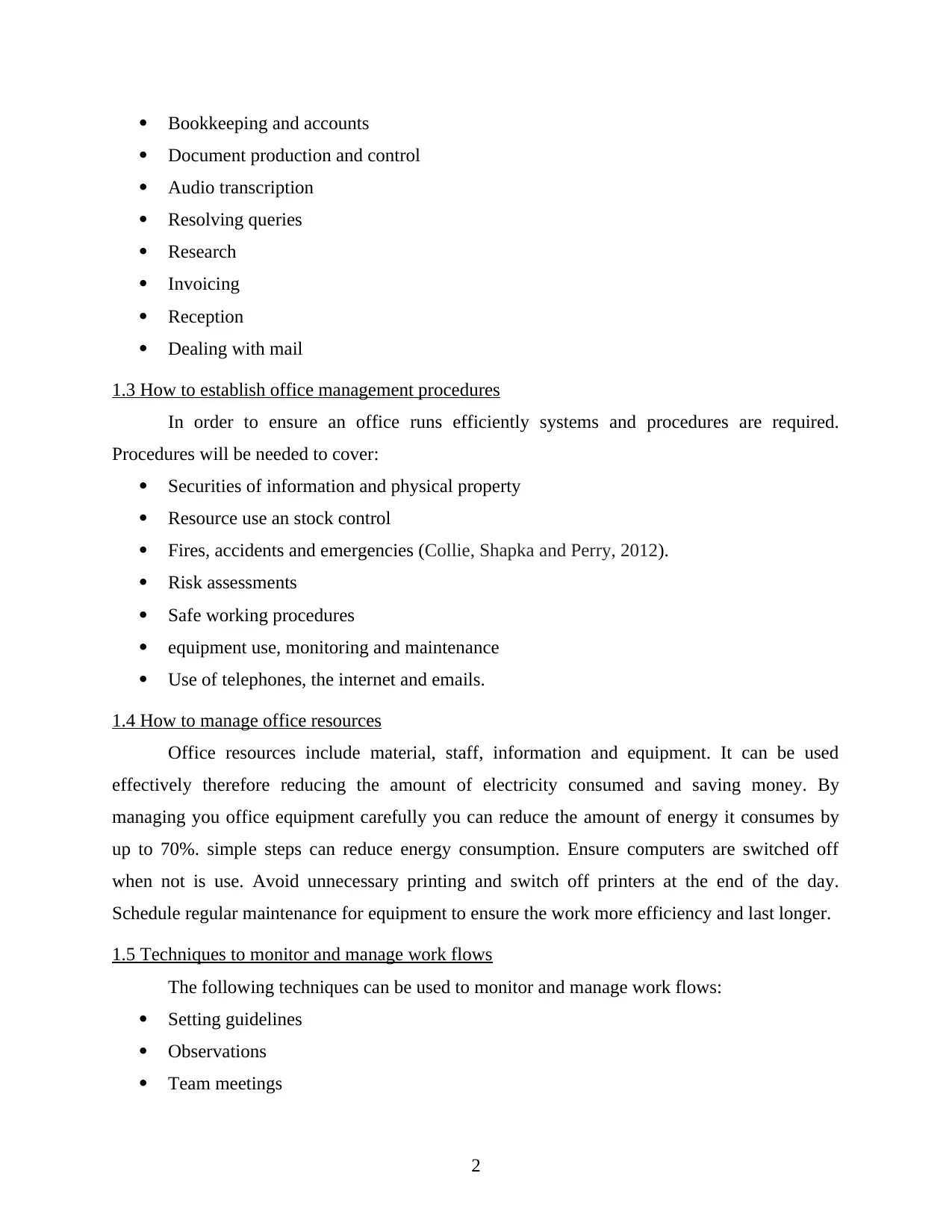
Bookkeeping and accounts
Document production and control
Audio transcription
Resolving queries
Research
Invoicing
Reception
Dealing with mail
1.3 How to establish office management procedures
In order to ensure an office runs efficiently systems and procedures are required.
Procedures will be needed to cover:
Securities of information and physical property
Resource use an stock control
Fires, accidents and emergencies (Collie, Shapka and Perry, 2012).
Risk assessments
Safe working procedures
equipment use, monitoring and maintenance
Use of telephones, the internet and emails.
1.4 How to manage office resources
Office resources include material, staff, information and equipment. It can be used
effectively therefore reducing the amount of electricity consumed and saving money. By
managing you office equipment carefully you can reduce the amount of energy it consumes by
up to 70%. simple steps can reduce energy consumption. Ensure computers are switched off
when not is use. Avoid unnecessary printing and switch off printers at the end of the day.
Schedule regular maintenance for equipment to ensure the work more efficiency and last longer.
1.5 Techniques to monitor and manage work flows
The following techniques can be used to monitor and manage work flows:
Setting guidelines
Observations
Team meetings
2
Document production and control
Audio transcription
Resolving queries
Research
Invoicing
Reception
Dealing with mail
1.3 How to establish office management procedures
In order to ensure an office runs efficiently systems and procedures are required.
Procedures will be needed to cover:
Securities of information and physical property
Resource use an stock control
Fires, accidents and emergencies (Collie, Shapka and Perry, 2012).
Risk assessments
Safe working procedures
equipment use, monitoring and maintenance
Use of telephones, the internet and emails.
1.4 How to manage office resources
Office resources include material, staff, information and equipment. It can be used
effectively therefore reducing the amount of electricity consumed and saving money. By
managing you office equipment carefully you can reduce the amount of energy it consumes by
up to 70%. simple steps can reduce energy consumption. Ensure computers are switched off
when not is use. Avoid unnecessary printing and switch off printers at the end of the day.
Schedule regular maintenance for equipment to ensure the work more efficiency and last longer.
1.5 Techniques to monitor and manage work flows
The following techniques can be used to monitor and manage work flows:
Setting guidelines
Observations
Team meetings
2
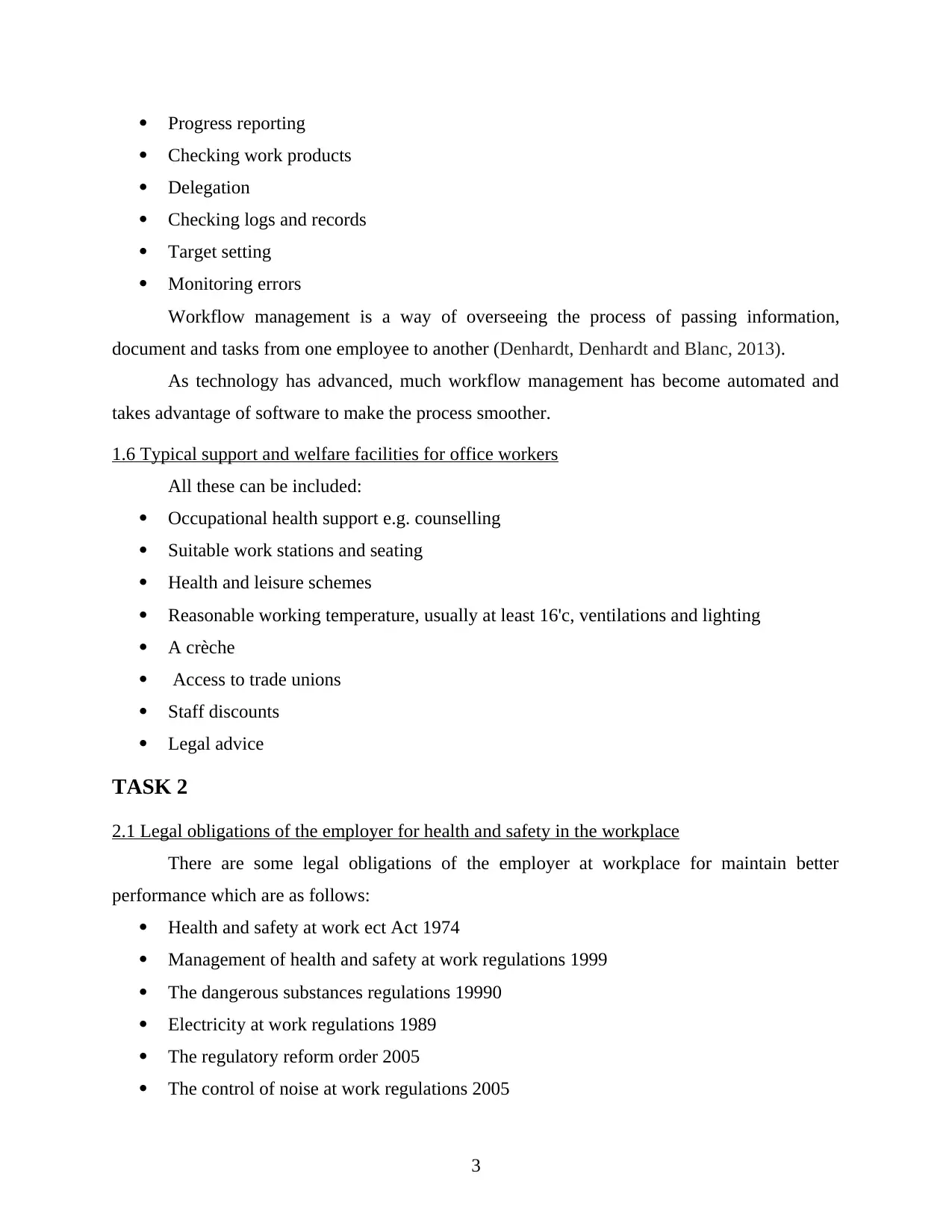
Progress reporting
Checking work products
Delegation
Checking logs and records
Target setting
Monitoring errors
Workflow management is a way of overseeing the process of passing information,
document and tasks from one employee to another (Denhardt, Denhardt and Blanc, 2013).
As technology has advanced, much workflow management has become automated and
takes advantage of software to make the process smoother.
1.6 Typical support and welfare facilities for office workers
All these can be included:
Occupational health support e.g. counselling
Suitable work stations and seating
Health and leisure schemes
Reasonable working temperature, usually at least 16'c, ventilations and lighting
A crèche
Access to trade unions
Staff discounts
Legal advice
TASK 2
2.1 Legal obligations of the employer for health and safety in the workplace
There are some legal obligations of the employer at workplace for maintain better
performance which are as follows:
Health and safety at work ect Act 1974
Management of health and safety at work regulations 1999
The dangerous substances regulations 19990
Electricity at work regulations 1989
The regulatory reform order 2005
The control of noise at work regulations 2005
3
Checking work products
Delegation
Checking logs and records
Target setting
Monitoring errors
Workflow management is a way of overseeing the process of passing information,
document and tasks from one employee to another (Denhardt, Denhardt and Blanc, 2013).
As technology has advanced, much workflow management has become automated and
takes advantage of software to make the process smoother.
1.6 Typical support and welfare facilities for office workers
All these can be included:
Occupational health support e.g. counselling
Suitable work stations and seating
Health and leisure schemes
Reasonable working temperature, usually at least 16'c, ventilations and lighting
A crèche
Access to trade unions
Staff discounts
Legal advice
TASK 2
2.1 Legal obligations of the employer for health and safety in the workplace
There are some legal obligations of the employer at workplace for maintain better
performance which are as follows:
Health and safety at work ect Act 1974
Management of health and safety at work regulations 1999
The dangerous substances regulations 19990
Electricity at work regulations 1989
The regulatory reform order 2005
The control of noise at work regulations 2005
3
⊘ This is a preview!⊘
Do you want full access?
Subscribe today to unlock all pages.

Trusted by 1+ million students worldwide
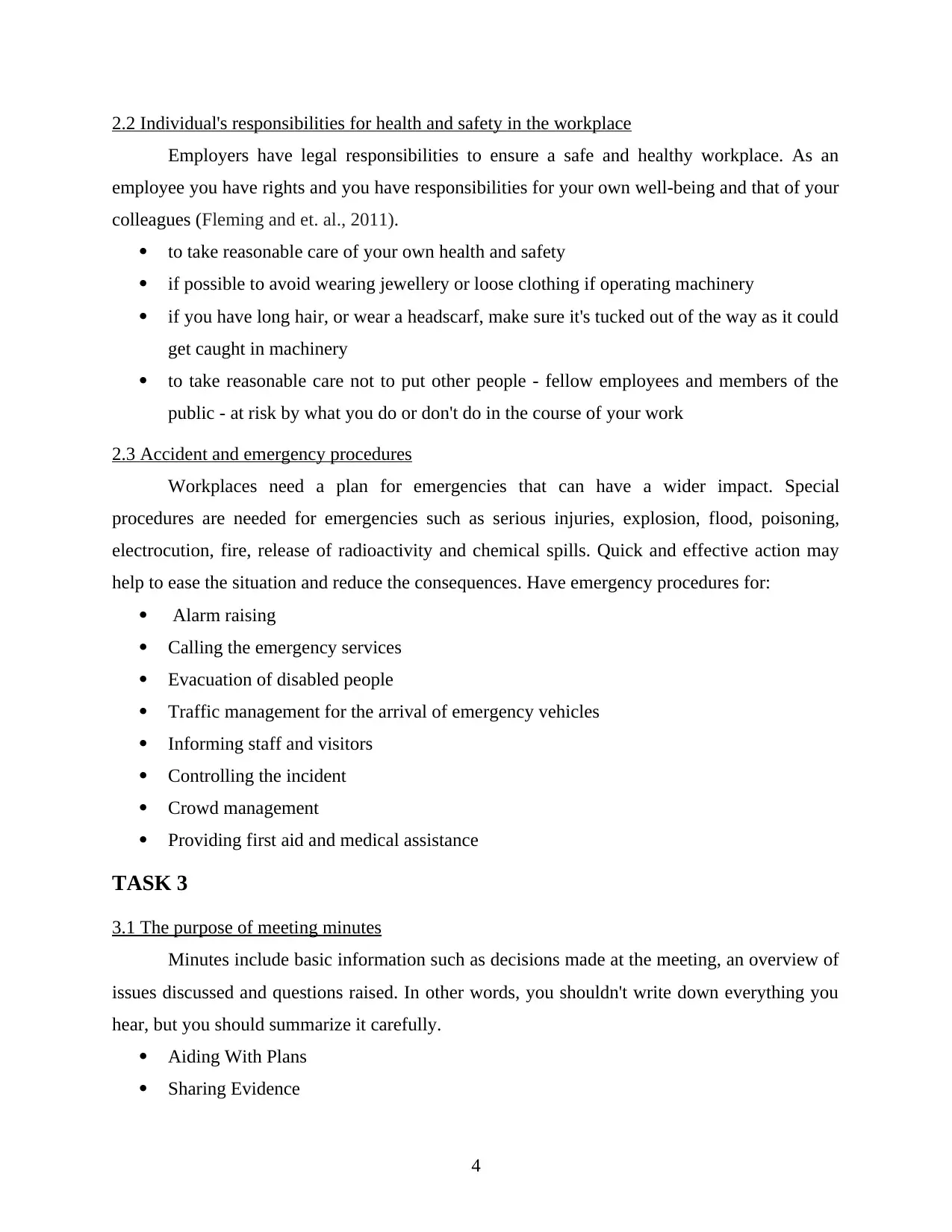
2.2 Individual's responsibilities for health and safety in the workplace
Employers have legal responsibilities to ensure a safe and healthy workplace. As an
employee you have rights and you have responsibilities for your own well-being and that of your
colleagues (Fleming and et. al., 2011).
to take reasonable care of your own health and safety
if possible to avoid wearing jewellery or loose clothing if operating machinery
if you have long hair, or wear a headscarf, make sure it's tucked out of the way as it could
get caught in machinery
to take reasonable care not to put other people - fellow employees and members of the
public - at risk by what you do or don't do in the course of your work
2.3 Accident and emergency procedures
Workplaces need a plan for emergencies that can have a wider impact. Special
procedures are needed for emergencies such as serious injuries, explosion, flood, poisoning,
electrocution, fire, release of radioactivity and chemical spills. Quick and effective action may
help to ease the situation and reduce the consequences. Have emergency procedures for:
Alarm raising
Calling the emergency services
Evacuation of disabled people
Traffic management for the arrival of emergency vehicles
Informing staff and visitors
Controlling the incident
Crowd management
Providing first aid and medical assistance
TASK 3
3.1 The purpose of meeting minutes
Minutes include basic information such as decisions made at the meeting, an overview of
issues discussed and questions raised. In other words, you shouldn't write down everything you
hear, but you should summarize it carefully.
Aiding With Plans
Sharing Evidence
4
Employers have legal responsibilities to ensure a safe and healthy workplace. As an
employee you have rights and you have responsibilities for your own well-being and that of your
colleagues (Fleming and et. al., 2011).
to take reasonable care of your own health and safety
if possible to avoid wearing jewellery or loose clothing if operating machinery
if you have long hair, or wear a headscarf, make sure it's tucked out of the way as it could
get caught in machinery
to take reasonable care not to put other people - fellow employees and members of the
public - at risk by what you do or don't do in the course of your work
2.3 Accident and emergency procedures
Workplaces need a plan for emergencies that can have a wider impact. Special
procedures are needed for emergencies such as serious injuries, explosion, flood, poisoning,
electrocution, fire, release of radioactivity and chemical spills. Quick and effective action may
help to ease the situation and reduce the consequences. Have emergency procedures for:
Alarm raising
Calling the emergency services
Evacuation of disabled people
Traffic management for the arrival of emergency vehicles
Informing staff and visitors
Controlling the incident
Crowd management
Providing first aid and medical assistance
TASK 3
3.1 The purpose of meeting minutes
Minutes include basic information such as decisions made at the meeting, an overview of
issues discussed and questions raised. In other words, you shouldn't write down everything you
hear, but you should summarize it carefully.
Aiding With Plans
Sharing Evidence
4
Paraphrase This Document
Need a fresh take? Get an instant paraphrase of this document with our AI Paraphraser
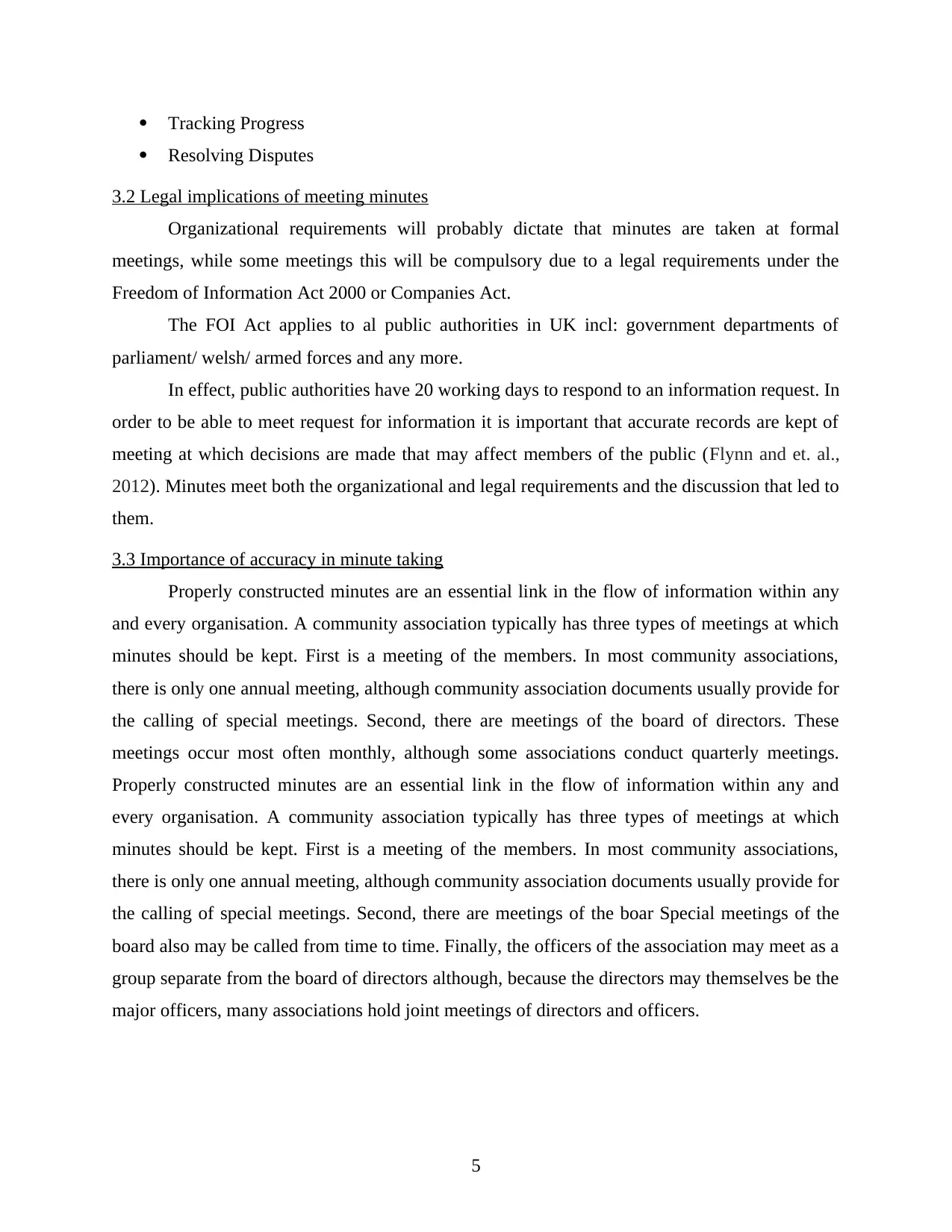
Tracking Progress
Resolving Disputes
3.2 Legal implications of meeting minutes
Organizational requirements will probably dictate that minutes are taken at formal
meetings, while some meetings this will be compulsory due to a legal requirements under the
Freedom of Information Act 2000 or Companies Act.
The FOI Act applies to al public authorities in UK incl: government departments of
parliament/ welsh/ armed forces and any more.
In effect, public authorities have 20 working days to respond to an information request. In
order to be able to meet request for information it is important that accurate records are kept of
meeting at which decisions are made that may affect members of the public (Flynn and et. al.,
2012). Minutes meet both the organizational and legal requirements and the discussion that led to
them.
3.3 Importance of accuracy in minute taking
Properly constructed minutes are an essential link in the flow of information within any
and every organisation. A community association typically has three types of meetings at which
minutes should be kept. First is a meeting of the members. In most community associations,
there is only one annual meeting, although community association documents usually provide for
the calling of special meetings. Second, there are meetings of the board of directors. These
meetings occur most often monthly, although some associations conduct quarterly meetings.
Properly constructed minutes are an essential link in the flow of information within any and
every organisation. A community association typically has three types of meetings at which
minutes should be kept. First is a meeting of the members. In most community associations,
there is only one annual meeting, although community association documents usually provide for
the calling of special meetings. Second, there are meetings of the boar Special meetings of the
board also may be called from time to time. Finally, the officers of the association may meet as a
group separate from the board of directors although, because the directors may themselves be the
major officers, many associations hold joint meetings of directors and officers.
5
Resolving Disputes
3.2 Legal implications of meeting minutes
Organizational requirements will probably dictate that minutes are taken at formal
meetings, while some meetings this will be compulsory due to a legal requirements under the
Freedom of Information Act 2000 or Companies Act.
The FOI Act applies to al public authorities in UK incl: government departments of
parliament/ welsh/ armed forces and any more.
In effect, public authorities have 20 working days to respond to an information request. In
order to be able to meet request for information it is important that accurate records are kept of
meeting at which decisions are made that may affect members of the public (Flynn and et. al.,
2012). Minutes meet both the organizational and legal requirements and the discussion that led to
them.
3.3 Importance of accuracy in minute taking
Properly constructed minutes are an essential link in the flow of information within any
and every organisation. A community association typically has three types of meetings at which
minutes should be kept. First is a meeting of the members. In most community associations,
there is only one annual meeting, although community association documents usually provide for
the calling of special meetings. Second, there are meetings of the board of directors. These
meetings occur most often monthly, although some associations conduct quarterly meetings.
Properly constructed minutes are an essential link in the flow of information within any and
every organisation. A community association typically has three types of meetings at which
minutes should be kept. First is a meeting of the members. In most community associations,
there is only one annual meeting, although community association documents usually provide for
the calling of special meetings. Second, there are meetings of the boar Special meetings of the
board also may be called from time to time. Finally, the officers of the association may meet as a
group separate from the board of directors although, because the directors may themselves be the
major officers, many associations hold joint meetings of directors and officers.
5
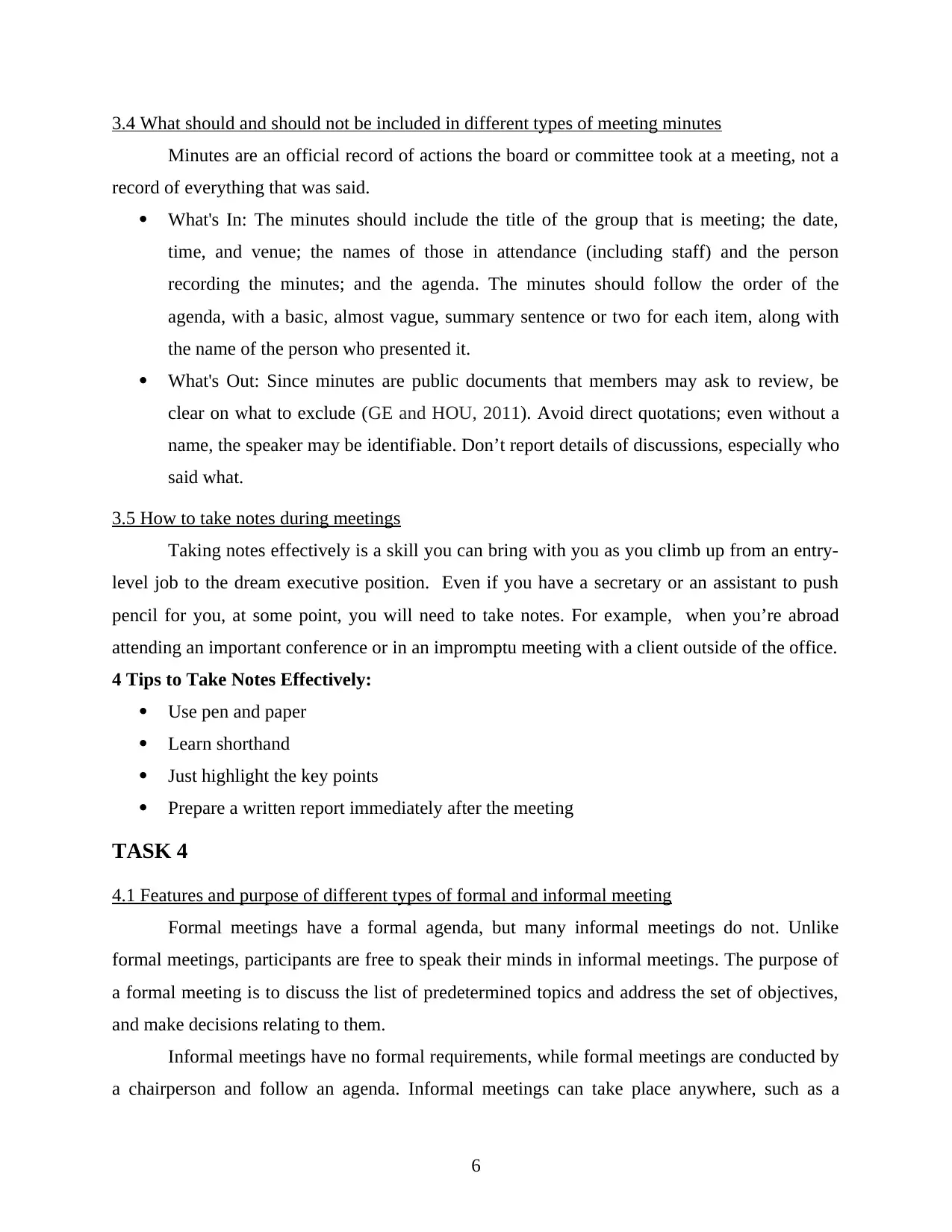
3.4 What should and should not be included in different types of meeting minutes
Minutes are an official record of actions the board or committee took at a meeting, not a
record of everything that was said.
What's In: The minutes should include the title of the group that is meeting; the date,
time, and venue; the names of those in attendance (including staff) and the person
recording the minutes; and the agenda. The minutes should follow the order of the
agenda, with a basic, almost vague, summary sentence or two for each item, along with
the name of the person who presented it.
What's Out: Since minutes are public documents that members may ask to review, be
clear on what to exclude (GE and HOU, 2011). Avoid direct quotations; even without a
name, the speaker may be identifiable. Don’t report details of discussions, especially who
said what.
3.5 How to take notes during meetings
Taking notes effectively is a skill you can bring with you as you climb up from an entry-
level job to the dream executive position. Even if you have a secretary or an assistant to push
pencil for you, at some point, you will need to take notes. For example, when you’re abroad
attending an important conference or in an impromptu meeting with a client outside of the office.
4 Tips to Take Notes Effectively:
Use pen and paper
Learn shorthand
Just highlight the key points
Prepare a written report immediately after the meeting
TASK 4
4.1 Features and purpose of different types of formal and informal meeting
Formal meetings have a formal agenda, but many informal meetings do not. Unlike
formal meetings, participants are free to speak their minds in informal meetings. The purpose of
a formal meeting is to discuss the list of predetermined topics and address the set of objectives,
and make decisions relating to them.
Informal meetings have no formal requirements, while formal meetings are conducted by
a chairperson and follow an agenda. Informal meetings can take place anywhere, such as a
6
Minutes are an official record of actions the board or committee took at a meeting, not a
record of everything that was said.
What's In: The minutes should include the title of the group that is meeting; the date,
time, and venue; the names of those in attendance (including staff) and the person
recording the minutes; and the agenda. The minutes should follow the order of the
agenda, with a basic, almost vague, summary sentence or two for each item, along with
the name of the person who presented it.
What's Out: Since minutes are public documents that members may ask to review, be
clear on what to exclude (GE and HOU, 2011). Avoid direct quotations; even without a
name, the speaker may be identifiable. Don’t report details of discussions, especially who
said what.
3.5 How to take notes during meetings
Taking notes effectively is a skill you can bring with you as you climb up from an entry-
level job to the dream executive position. Even if you have a secretary or an assistant to push
pencil for you, at some point, you will need to take notes. For example, when you’re abroad
attending an important conference or in an impromptu meeting with a client outside of the office.
4 Tips to Take Notes Effectively:
Use pen and paper
Learn shorthand
Just highlight the key points
Prepare a written report immediately after the meeting
TASK 4
4.1 Features and purpose of different types of formal and informal meeting
Formal meetings have a formal agenda, but many informal meetings do not. Unlike
formal meetings, participants are free to speak their minds in informal meetings. The purpose of
a formal meeting is to discuss the list of predetermined topics and address the set of objectives,
and make decisions relating to them.
Informal meetings have no formal requirements, while formal meetings are conducted by
a chairperson and follow an agenda. Informal meetings can take place anywhere, such as a
6
⊘ This is a preview!⊘
Do you want full access?
Subscribe today to unlock all pages.

Trusted by 1+ million students worldwide
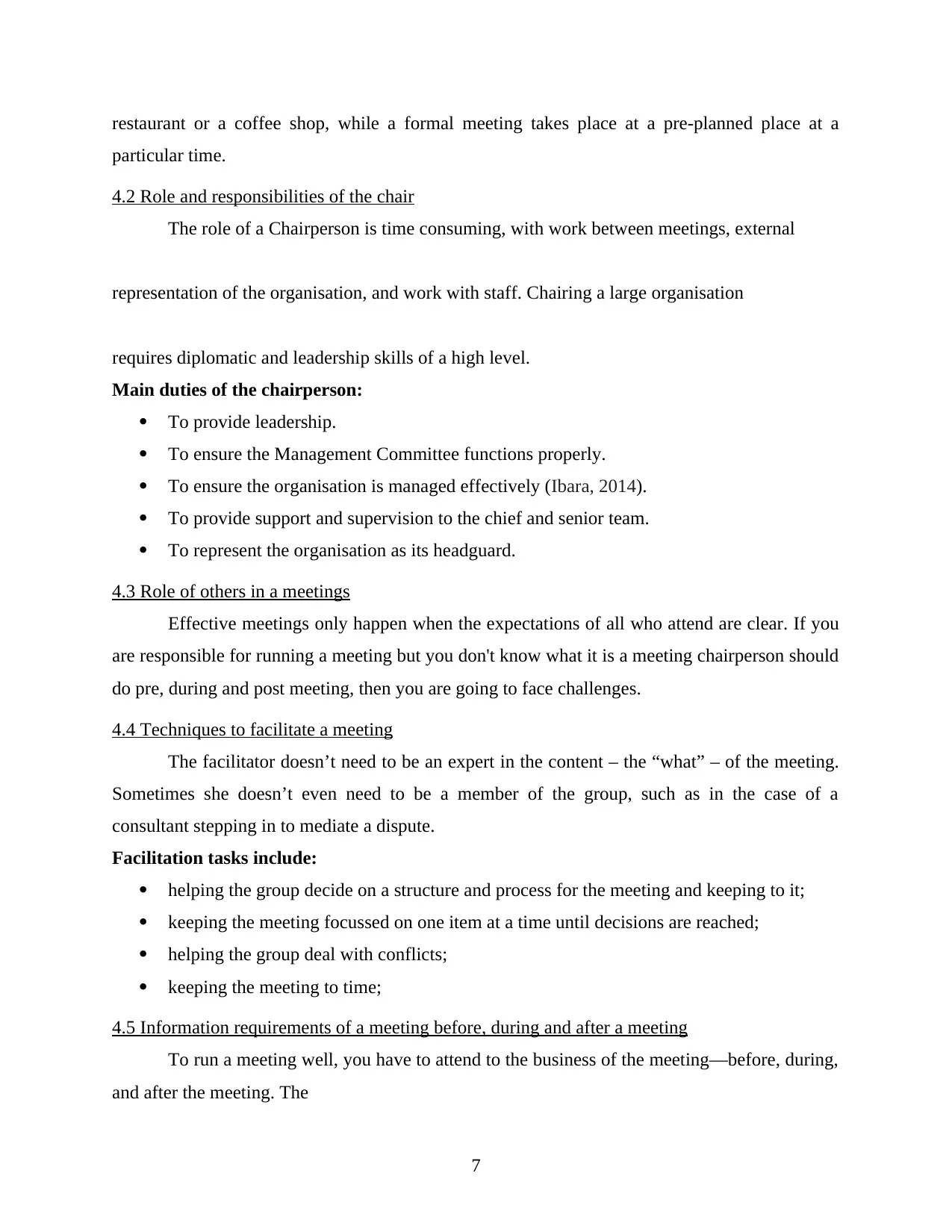
restaurant or a coffee shop, while a formal meeting takes place at a pre-planned place at a
particular time.
4.2 Role and responsibilities of the chair
The role of a Chairperson is time consuming, with work between meetings, external
representation of the organisation, and work with staff. Chairing a large organisation
requires diplomatic and leadership skills of a high level.
Main duties of the chairperson:
To provide leadership.
To ensure the Management Committee functions properly.
To ensure the organisation is managed effectively (Ibara, 2014).
To provide support and supervision to the chief and senior team.
To represent the organisation as its headguard.
4.3 Role of others in a meetings
Effective meetings only happen when the expectations of all who attend are clear. If you
are responsible for running a meeting but you don't know what it is a meeting chairperson should
do pre, during and post meeting, then you are going to face challenges.
4.4 Techniques to facilitate a meeting
The facilitator doesn’t need to be an expert in the content – the “what” – of the meeting.
Sometimes she doesn’t even need to be a member of the group, such as in the case of a
consultant stepping in to mediate a dispute.
Facilitation tasks include:
helping the group decide on a structure and process for the meeting and keeping to it;
keeping the meeting focussed on one item at a time until decisions are reached;
helping the group deal with conflicts;
keeping the meeting to time;
4.5 Information requirements of a meeting before, during and after a meeting
To run a meeting well, you have to attend to the business of the meeting—before, during,
and after the meeting. The
7
particular time.
4.2 Role and responsibilities of the chair
The role of a Chairperson is time consuming, with work between meetings, external
representation of the organisation, and work with staff. Chairing a large organisation
requires diplomatic and leadership skills of a high level.
Main duties of the chairperson:
To provide leadership.
To ensure the Management Committee functions properly.
To ensure the organisation is managed effectively (Ibara, 2014).
To provide support and supervision to the chief and senior team.
To represent the organisation as its headguard.
4.3 Role of others in a meetings
Effective meetings only happen when the expectations of all who attend are clear. If you
are responsible for running a meeting but you don't know what it is a meeting chairperson should
do pre, during and post meeting, then you are going to face challenges.
4.4 Techniques to facilitate a meeting
The facilitator doesn’t need to be an expert in the content – the “what” – of the meeting.
Sometimes she doesn’t even need to be a member of the group, such as in the case of a
consultant stepping in to mediate a dispute.
Facilitation tasks include:
helping the group decide on a structure and process for the meeting and keeping to it;
keeping the meeting focussed on one item at a time until decisions are reached;
helping the group deal with conflicts;
keeping the meeting to time;
4.5 Information requirements of a meeting before, during and after a meeting
To run a meeting well, you have to attend to the business of the meeting—before, during,
and after the meeting. The
7
Paraphrase This Document
Need a fresh take? Get an instant paraphrase of this document with our AI Paraphraser
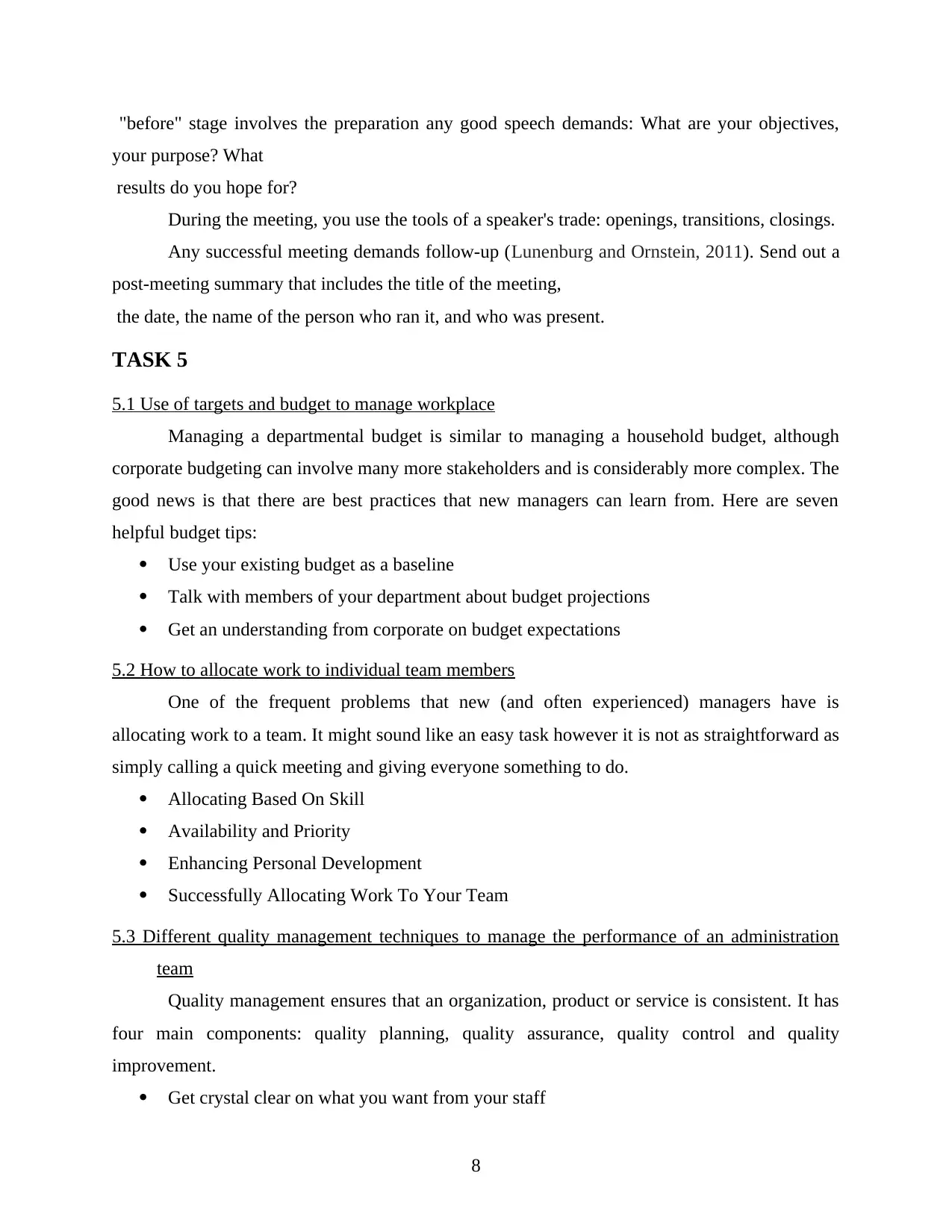
"before" stage involves the preparation any good speech demands: What are your objectives,
your purpose? What
results do you hope for?
During the meeting, you use the tools of a speaker's trade: openings, transitions, closings.
Any successful meeting demands follow-up (Lunenburg and Ornstein, 2011). Send out a
post-meeting summary that includes the title of the meeting,
the date, the name of the person who ran it, and who was present.
TASK 5
5.1 Use of targets and budget to manage workplace
Managing a departmental budget is similar to managing a household budget, although
corporate budgeting can involve many more stakeholders and is considerably more complex. The
good news is that there are best practices that new managers can learn from. Here are seven
helpful budget tips:
Use your existing budget as a baseline
Talk with members of your department about budget projections
Get an understanding from corporate on budget expectations
5.2 How to allocate work to individual team members
One of the frequent problems that new (and often experienced) managers have is
allocating work to a team. It might sound like an easy task however it is not as straightforward as
simply calling a quick meeting and giving everyone something to do.
Allocating Based On Skill
Availability and Priority
Enhancing Personal Development
Successfully Allocating Work To Your Team
5.3 Different quality management techniques to manage the performance of an administration
team
Quality management ensures that an organization, product or service is consistent. It has
four main components: quality planning, quality assurance, quality control and quality
improvement.
Get crystal clear on what you want from your staff
8
your purpose? What
results do you hope for?
During the meeting, you use the tools of a speaker's trade: openings, transitions, closings.
Any successful meeting demands follow-up (Lunenburg and Ornstein, 2011). Send out a
post-meeting summary that includes the title of the meeting,
the date, the name of the person who ran it, and who was present.
TASK 5
5.1 Use of targets and budget to manage workplace
Managing a departmental budget is similar to managing a household budget, although
corporate budgeting can involve many more stakeholders and is considerably more complex. The
good news is that there are best practices that new managers can learn from. Here are seven
helpful budget tips:
Use your existing budget as a baseline
Talk with members of your department about budget projections
Get an understanding from corporate on budget expectations
5.2 How to allocate work to individual team members
One of the frequent problems that new (and often experienced) managers have is
allocating work to a team. It might sound like an easy task however it is not as straightforward as
simply calling a quick meeting and giving everyone something to do.
Allocating Based On Skill
Availability and Priority
Enhancing Personal Development
Successfully Allocating Work To Your Team
5.3 Different quality management techniques to manage the performance of an administration
team
Quality management ensures that an organization, product or service is consistent. It has
four main components: quality planning, quality assurance, quality control and quality
improvement.
Get crystal clear on what you want from your staff
8
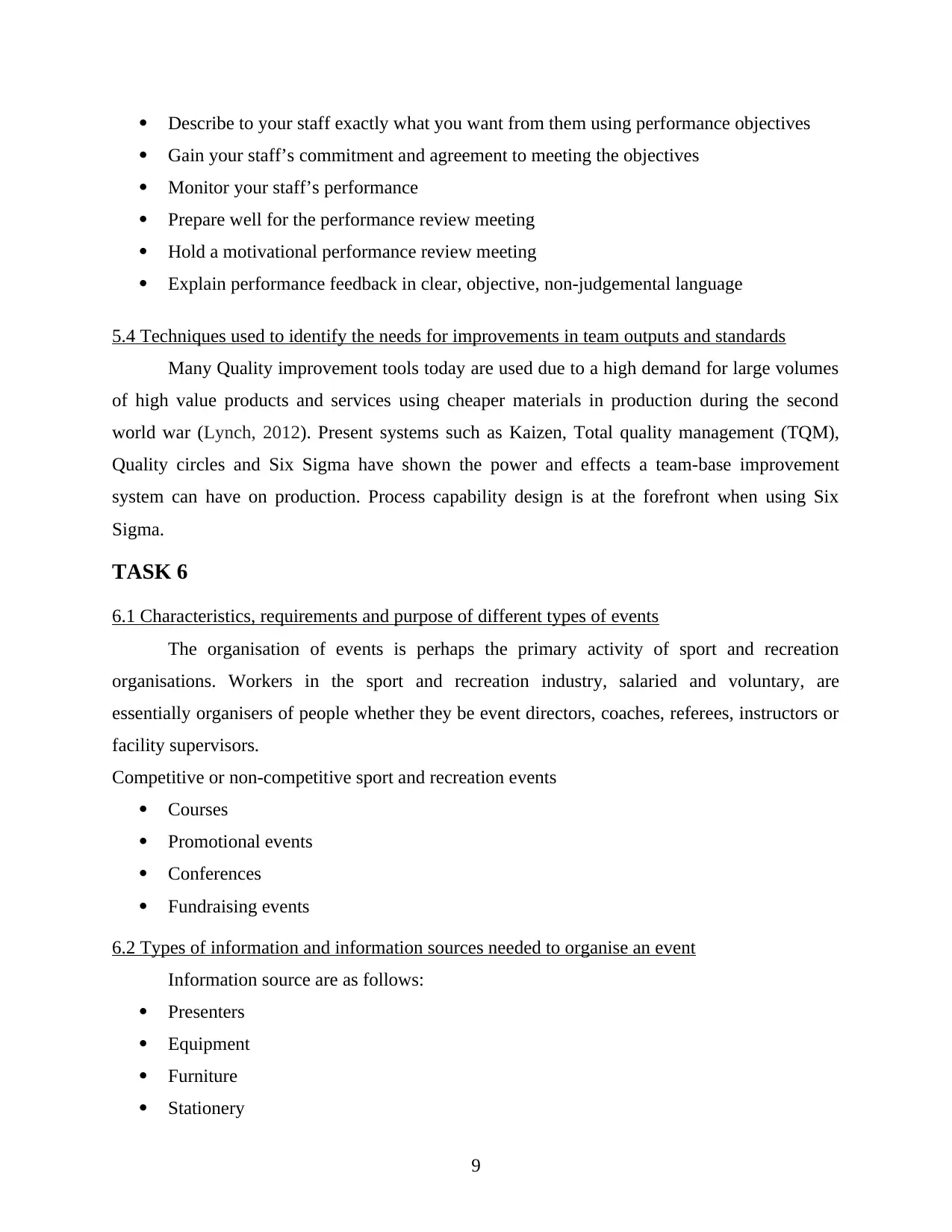
Describe to your staff exactly what you want from them using performance objectives
Gain your staff’s commitment and agreement to meeting the objectives
Monitor your staff’s performance
Prepare well for the performance review meeting
Hold a motivational performance review meeting
Explain performance feedback in clear, objective, non-judgemental language
5.4 Techniques used to identify the needs for improvements in team outputs and standards
Many Quality improvement tools today are used due to a high demand for large volumes
of high value products and services using cheaper materials in production during the second
world war (Lynch, 2012). Present systems such as Kaizen, Total quality management (TQM),
Quality circles and Six Sigma have shown the power and effects a team-base improvement
system can have on production. Process capability design is at the forefront when using Six
Sigma.
TASK 6
6.1 Characteristics, requirements and purpose of different types of events
The organisation of events is perhaps the primary activity of sport and recreation
organisations. Workers in the sport and recreation industry, salaried and voluntary, are
essentially organisers of people whether they be event directors, coaches, referees, instructors or
facility supervisors.
Competitive or non-competitive sport and recreation events
Courses
Promotional events
Conferences
Fundraising events
6.2 Types of information and information sources needed to organise an event
Information source are as follows:
Presenters
Equipment
Furniture
Stationery
9
Gain your staff’s commitment and agreement to meeting the objectives
Monitor your staff’s performance
Prepare well for the performance review meeting
Hold a motivational performance review meeting
Explain performance feedback in clear, objective, non-judgemental language
5.4 Techniques used to identify the needs for improvements in team outputs and standards
Many Quality improvement tools today are used due to a high demand for large volumes
of high value products and services using cheaper materials in production during the second
world war (Lynch, 2012). Present systems such as Kaizen, Total quality management (TQM),
Quality circles and Six Sigma have shown the power and effects a team-base improvement
system can have on production. Process capability design is at the forefront when using Six
Sigma.
TASK 6
6.1 Characteristics, requirements and purpose of different types of events
The organisation of events is perhaps the primary activity of sport and recreation
organisations. Workers in the sport and recreation industry, salaried and voluntary, are
essentially organisers of people whether they be event directors, coaches, referees, instructors or
facility supervisors.
Competitive or non-competitive sport and recreation events
Courses
Promotional events
Conferences
Fundraising events
6.2 Types of information and information sources needed to organise an event
Information source are as follows:
Presenters
Equipment
Furniture
Stationery
9
⊘ This is a preview!⊘
Do you want full access?
Subscribe today to unlock all pages.

Trusted by 1+ million students worldwide
1 out of 15
Related Documents
Your All-in-One AI-Powered Toolkit for Academic Success.
+13062052269
info@desklib.com
Available 24*7 on WhatsApp / Email
![[object Object]](/_next/static/media/star-bottom.7253800d.svg)
Unlock your academic potential
Copyright © 2020–2025 A2Z Services. All Rights Reserved. Developed and managed by ZUCOL.





